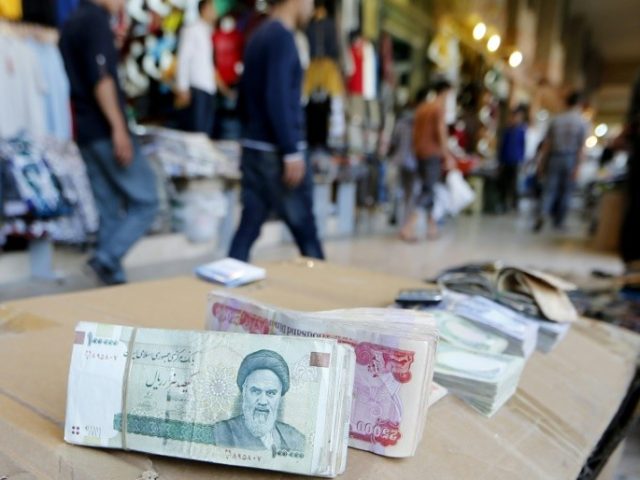Almost immediately after the U.S. announced the return of international sanctions on Iran on Sunday, the Iranian rial fell to record lows against the U.S. dollar, Radio Farda reported on Monday.
In 2007, the U.N. Security Council imposed an arms embargo on Iran. The embargo was due to expire on October 18, per the terms agreed to under a 2015 Iran nuclear deal meant to prevent the rogue nation from developing nuclear weapons in return for sanctions relief. In 2018, the U.S. quit the 2015 agreement, known formally as the Joint Comprehensive Plan of Action (JCPOA). After trying unsuccessfully last month to extend the Iran arms embargo, the U.S. on Saturday said it would reimpose sanctions on Iran via “snapback” process.
“Sanctions are being re-imposed on Iran pursuant to the snapback process under [a] UN Security Council resolution,” U.S. Secretary of State Mike Pompeo said in a press statement on Saturday.
“On August 20, the United States notified the President of the [UN] Security Council of Iran’s significant non-performance of its JCPOA [Joint Comprehensive Plan of Action] commitments. This notification triggered the 30-day process leading to the snapback of previously terminated UN sanctions, which became effective … on September 19,” the statement read.
Shortly after the announcement, the dollar exchange rate in Iran “set a new record high with a 2.5 percent increase to the rate of 273,000 [Iranian] rials per dollar,” according to Radio Farda. On March 20, the start of the Iranian new year, the U.S. dollar exchange rate was 160,000 rials. It had previously reached 250,000 rials in late July.
In the last week of June, the Central Bank of Iran (CBI) injected roughly “one billion dollars of foreign exchange into the local market, and the price of the dollar fell to 210,000 rials,” according to the report. After some time, the exchange rate began to fluctuate again.
The price of Iran’s “Imami” gold bullion coin “also increased by 4 percent to 132,640,000 rials (roughly $3,000) on Sunday, setting another record,” Radio Farda noted. The price of other types of Iranian coins also increased dramatically.
In mid-September, CBI Governor Abdol Nasser Hemmati claimed that, in addition to “heavily supplying the NIMA (forex) market with hard currencies,” he had also authorized “petrochemicals, steels, and minerals firms to transact their export currency directly at the licensed exchange bureaus outside the CBI.”
Economic analysts observing Iran’s financial markets doubt the CBI’s ability to “heavily” supply the market with the much-needed hard currencies. Supporting the analysts’ skepticism is the daily increase in price of various foreign currencies in Iran.
The International Monetary Fund (IMF) predicted this year that Iran’s foreign exchange reserves would decrease by about $19 billion in 2020 to $85 billion, and decrease further to $69 billion in 2021.
“A significant part of Iran’s foreign exchange reserves is blocked abroad, and Iran can only use them to import authorized goods. This year, for the first time, Iran’s foreign trade balance has turned negative, and there appears to be no hope of improving the country’s foreign exchange reserves,” Radio Farda noted.
IMF’s forecast also expects Iran’s total oil and related services exports to reach $46 billion this year, and its imports to exceed $64 billion. Iran’s export numbers reached $100 billion prior to U.S. sanctions.
The Tehran Stock Exchange (TSE) index fell by over 47,000 units on Sunday. The TSE index at the beginning of this Iranian solar calendar year (March 20) was about 500,000 units. Despite Iran facing a decline in GDP for the third consecutive year amid the backdrop of its ongoing economic crisis, “the stock index strangely exceeded two million units in mid-August,” Radio Farda noted.
Financial experts told the news outlet that this odd occurrence indicates “government manipulation of the TSE and the existence of bubbles in the market.”
The TSE index started to fall sharply starting on August 10. It reached 1,650,000 units on Sunday.

COMMENTS
Please let us know if you're having issues with commenting.